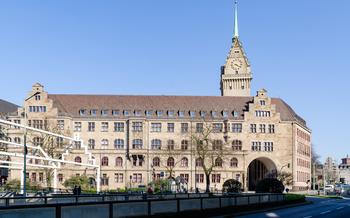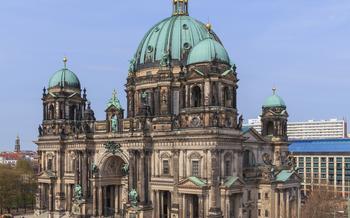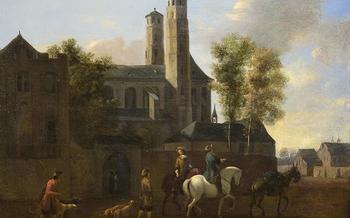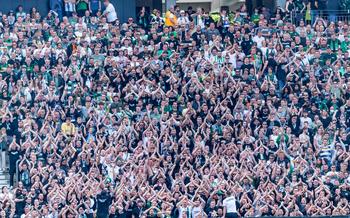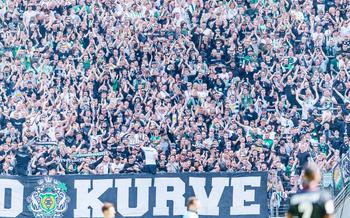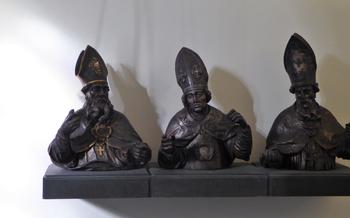
St. Vitus Church
- Historical Significance
- Architectural Masterpiece
- Interior Splendors
- St. Vitus Shrine: A Beacon of Devotion and Pilgrimage
- Religious Services
- Cultural Events
- Guided Tours
- Accessibility and Location
- Opening Hours and Admission
- Photography and Videography
- Dress Code and Etiquette
- Local Customs and Traditions
- Accessibility for Disabled Visitors
- Souvenirs and Merchandise
- Insider Tip: The Hidden Crypt
Historical Significance
The St. Vitus Church in Mönchengladbach is a testament to the city's rich history and religious heritage. Its roots date back to the 10th century when a small chapel stood on the site. Over time, the chapel was expanded and transformed into a Romanesque basilica, reflecting the growing importance of Christianity in the region. Throughout the centuries, the church has undergone several renovations and expansions, blending architectural styles and showcasing the artistic and cultural influences of different eras.
Despite numerous wars and conflicts that ravaged Mönchengladbach, the St. Vitus Church remarkably survived, standing as a symbol of resilience and faith. Its enduring presence earned it the status of a protected historical monument, ensuring its preservation for future generations. Today, the church continues to serve as a spiritual beacon for the local community, attracting visitors from around the world who come to admire its architectural grandeur and experience its sacred atmosphere.
Architectural Masterpiece
The St. Vitus Church stands as a testament to the architectural prowess of its time. Built in a harmonious blend of Romanesque and Gothic styles, the church's exterior boasts a captivating presence. Its twin towers, reaching towards the heavens, dominate the city skyline, serving as a beacon for both locals and visitors. The intricate carvings and sculptures that adorn the facade depict scenes from the Bible and the lives of saints, adding a touch of sacred elegance to the building. Inside, the church's beauty continues to unfold. The spacious interior, with its vaulted ceilings and elegant pillars, creates an atmosphere of awe and reverence. The walls are adorned with an impressive collection of religious artworks, including paintings, sculptures, and tapestries, each narrating a chapter of the church's rich history. Among these treasures, the magnificent altarpieces stand out, particularly the High Altar with its intricate carvings and gold leaf, a testament to the craftsmanship of a bygone era.
Interior Splendors
The interior of St. Vitus Church is a testament to its rich history and artistic heritage. The spacious nave, with its vaulted ceilings and elegant pillars, creates a sense of awe and grandeur. The walls are adorned with intricate carvings and sculptures that depict scenes from the Bible and the lives of saints. The stained glass windows, with their vibrant colors and intricate designs, cast a warm and ethereal glow throughout the interior.
At the heart of the church is the magnificent High Altar, a masterpiece of Gothic craftsmanship. The altar is carved from intricately detailed wood and adorned with gold leaf, creating a stunning visual spectacle. The altarpieces, which depict scenes from the life of Jesus Christ, are particularly noteworthy for their artistic merit and historical significance.
The church also houses a number of side chapels, each with its own unique character and history. The Chapel of St. Anthony, for example, features a stunning altarpiece dedicated to the saint, while the Chapel of the Holy Cross is home to a beautifully carved crucifix. These chapels provide a place for quiet reflection and prayer, adding to the spiritual atmosphere of the church.
St. Vitus Shrine: A Beacon of Devotion and Pilgrimage
At the heart of St. Vitus Church lies a sacred treasure that draws thousands of devotees from near and far - the St. Vitus Shrine. Elaborately adorned and positioned prominently in the center of the church, this shrine holds the relics of St. Vitus, the patron saint of Mönchengladbach.
St. Vitus, a young Christian martyr from the 4th century, is revered for his unwavering faith and courage in the face of persecution. His relics, believed to possess miraculous powers, were brought to Mönchengladbach in the 9th century and have since become a symbol of hope and inspiration for generations of believers.
The shrine itself is a masterpiece of craftsmanship, adorned with intricate carvings, sculptures, and precious stones. It serves as a fitting tribute to the saint and invites pilgrims to reflect on his life and teachings.
Each year, on June 15th, the church celebrates the feast of St. Vitus with a grand pilgrimage. Thousands of pilgrims from across the region flock to Mönchengladbach to pay homage to the saint and seek his blessings. During this special occasion, the shrine becomes a focal point of devotion, with prayers, hymns, and processions filling the air.
Whether you're a devout believer or simply a curious traveler, the St. Vitus Shrine is a must-visit attraction in Mönchengladbach. Its historical significance, artistic beauty, and spiritual aura make it a place of profound reverence and inspiration.
Religious Services
The St. Vitus Church in Mönchengladbach is not just a historical and architectural marvel; it is also a vibrant center of religious activity. The church offers a variety of religious services that cater to the spiritual needs of the local community and visitors alike. Regular masses are held throughout the week, providing opportunities for worship, prayer, and contemplation. These services are conducted in German, allowing visitors to immerse themselves in the local culture and traditions.
In addition to masses, the church also hosts special religious events such as baptisms, weddings, and confirmations. These services hold great significance for the local community, as they mark important milestones in the lives of individuals and families. The church's spacious interior and beautiful surroundings provide a fitting backdrop for these special occasions, creating a memorable and spiritual experience for all involved.
The St. Vitus Church is more than just a place of worship; it is a spiritual home for many in the community. It offers guidance, support, and a sense of belonging to its congregation. Visitors are welcome to attend any of the religious services, regardless of their faith or background. The welcoming atmosphere and the beauty of the church create a conducive environment for spiritual reflection and connection with the divine.
Cultural Events
The St. Vitus Church in Mönchengladbach is not just a place of worship but also a vibrant cultural hub. Throughout the year, the church hosts a variety of cultural events that showcase its rich history and heritage. These events are open to the public and offer a unique opportunity to immerse oneself in the cultural tapestry of the city.
One of the highlights of the church's cultural calendar is the annual concert series, which features performances by renowned musicians and choirs. Classical music enthusiasts can enjoy the melodious strains of Bach, Mozart, and Beethoven, while contemporary music lovers can groove to the rhythms of jazz, blues, and folk.
The church also hosts regular exhibitions that delve into its fascinating past. These exhibitions showcase artifacts, documents, and artwork that erzählen the story of the church's construction, its role in the community, and its survival through wars and conflicts. Visitors can gain insights into the lives of the people who built and worshipped in the church, and learn about the events that shaped its history.
In addition to concerts and exhibitions, the church also organizes lectures and workshops on a variety of topics related to its history, architecture, and art. These events are led by experts in their respective fields and offer attendees a chance to deepen their understanding of the church's significance.
Attending a cultural event at the St. Vitus Church is a wonderful way to experience the city's vibrant cultural scene and learn more about its rich history. Whether you're a music lover, a history buff, or simply someone who appreciates beautiful architecture, there's something for everyone at this remarkable church.
Guided Tours
The St. Vitus Church offers guided tours that provide an immersive and informative experience for visitors. These tours are led by knowledgeable guides who share fascinating insights into the church's history, architecture, and religious significance. Different types of tours are available, catering to various interests and preferences.
For a comprehensive overview, the general tour covers the church's key features, including its architectural highlights, interior splendors, and the St. Vitus shrine. The historical tour delves deeper into the church's rich past, exploring its role in shaping Mönchengladbach's religious and cultural landscape. The architectural tour focuses on the church's unique Romanesque-Gothic style, highlighting its intricate details and symbolism.
Taking a guided tour is highly recommended, as it allows visitors to gain a deeper understanding of the church's significance and appreciate its beauty from an informed perspective. It is advisable to book a tour in advance to secure a spot, especially during peak tourist season.
Accessibility and Location
The St. Vitus Church is conveniently located in the heart of Mönchengladbach, making it easily accessible by various means of transportation. For those arriving by public transport, the church is a short walk from the Mönchengladbach Hauptbahnhof (main train station). Several bus lines also stop nearby, providing easy connections from different parts of the city.
For those traveling by car, the church offers ample parking spaces in the surrounding area. Visitors can use the nearby public parking garage or find street parking in the vicinity. The church's exact address is Münsterplatz 10, 41061 Mönchengladbach, Germany.
After visiting the church, take some time to explore the surrounding area. The Old Town of Mönchengladbach, with its charming cobblestone streets and historical buildings, is just a short walk away. Visitors can also find a variety of shops, restaurants, and cafes in the vicinity, making it a great place to spend an afternoon or evening.
Opening Hours and Admission
St. Vitus Church is open to the public daily, offering visitors the opportunity to explore its beauty and history. The church's opening hours may vary depending on the day of the week, so it's advisable to check in advance to avoid any inconvenience. On weekdays, the church is typically open from morning until evening, while on weekends and holidays, it may have extended hours. Special hours or closures may be implemented during religious holidays or significant events, so it's essential to stay informed.
Admission to the church is generally free of charge, allowing visitors to experience its grandeur without any financial barriers. However, some special events or guided tours may require a nominal fee or donation. If applicable, information about admission fees and any discounts or concessions offered will be clearly displayed at the church entrance or on the church's official website.
To fully appreciate the church's history and architecture, it's recommended to visit during off-peak hours to avoid crowds and distractions. This will allow visitors to take their time exploring the church's interior, admiring its intricate details and soaking in its serene atmosphere.
Photography and Videography
The St. Vitus Church welcomes visitors to capture the beauty and grandeur of its interior through photography and videography. However, to ensure a respectful and serene environment, certain guidelines must be followed. Photography and videography are permitted for personal, non-commercial purposes only. Visitors are requested to use their cameras and devices discreetly, avoiding flash photography and tripods that may obstruct walkways or disturb other visitors. It is important to maintain silence and refrain from disruptive activities while taking photos or videos. By respecting these guidelines, visitors can preserve the sacred atmosphere of the church while capturing their memories of this remarkable landmark.
Dress Code and Etiquette
When visiting St. Vitus Church, it is essential to observe appropriate dress and behavior. As a place of worship, the church maintains a solemn and respectful atmosphere. Visitors are expected to dress modestly and avoid revealing or casual attire. It is recommended to wear clothing that covers the shoulders, knees, and chest. While inside the church, silence and reverence are expected. Refrain from loud conversations, laughter, or disruptive activities that may disturb other visitors or ongoing religious services. Be mindful of the sacredness of the space and show respect for the spiritual significance of the church.
Local Customs and Traditions
The St. Vitus Church is deeply embedded in the local customs and traditions of Mönchengladbach. One notable tradition is the annual pilgrimage to the St. Vitus shrine, which takes place on June 15th, the feast day of the saint. Thousands of devotees from across the region flock to the church to pay homage to St. Vitus and seek his blessings.
During the pilgrimage, the church is adorned with colorful banners and flowers, and the air is filled with the sound of prayers and hymns. Devotees participate in a solemn procession, carrying a statue of St. Vitus through the streets of Mönchengladbach. The procession is followed by a special mass held in the church, where pilgrims can receive blessings and indulgences.
The St. Vitus pilgrimage is a testament to the enduring faith and devotion of the local community. It's a vibrant celebration that showcases the deep connection between the people of Mönchengladbach and their patron saint. Visitors to the church during this time can witness a unique and moving display of religious fervor and cultural heritage.
Accessibility for Disabled Visitors
The St. Vitus Church is committed to ensuring that all visitors, regardless of their abilities, can enjoy its beauty and history. The church is equipped with several accessibility features to accommodate disabled visitors. Ramps and elevators provide easy access to all levels of the church, including the choir loft and the crypt. Designated seating areas for wheelchair users are available in the nave and the side aisles. The church also offers assistive listening devices for those with hearing impairments. For visitors with specific accessibility needs, it is recommended to contact the church in advance to make arrangements. The church staff is dedicated to providing a welcoming and inclusive environment for all visitors, ensuring that everyone can have a meaningful and memorable experience at St. Vitus Church.
Souvenirs and Merchandise
Visitors to St. Vitus Church can purchase a variety of souvenirs and merchandise to commemorate their visit. The church's official shop offers a wide range of items, including postcards, books, and religious objects. These souvenirs are not only beautiful mementos of a visit to the church but also a way to support its ongoing preservation and restoration efforts.
From intricate replicas of the church's famous sculptures to books detailing its rich history, there is something for everyone at the church shop. Visitors can also purchase candles, rosaries, and other religious items to use during their visit or take home as a reminder of their spiritual journey.
By purchasing souvenirs from the church's official shop, visitors can help ensure that this historic landmark continues to stand as a beacon of faith and inspiration for generations to come.
Insider Tip: The Hidden Crypt
Beneath the grand St. Vitus Church lies a hidden gem that few visitors know about—the crypt. This atmospheric underground chamber dates back to the 11th century and served as the final resting place for many notable figures throughout history. Explore the crypt to discover ancient tombs, intricate carvings, and remnants of past eras. Descend into the shadows to uncover the hidden stories that lie beneath this sacred ground.
